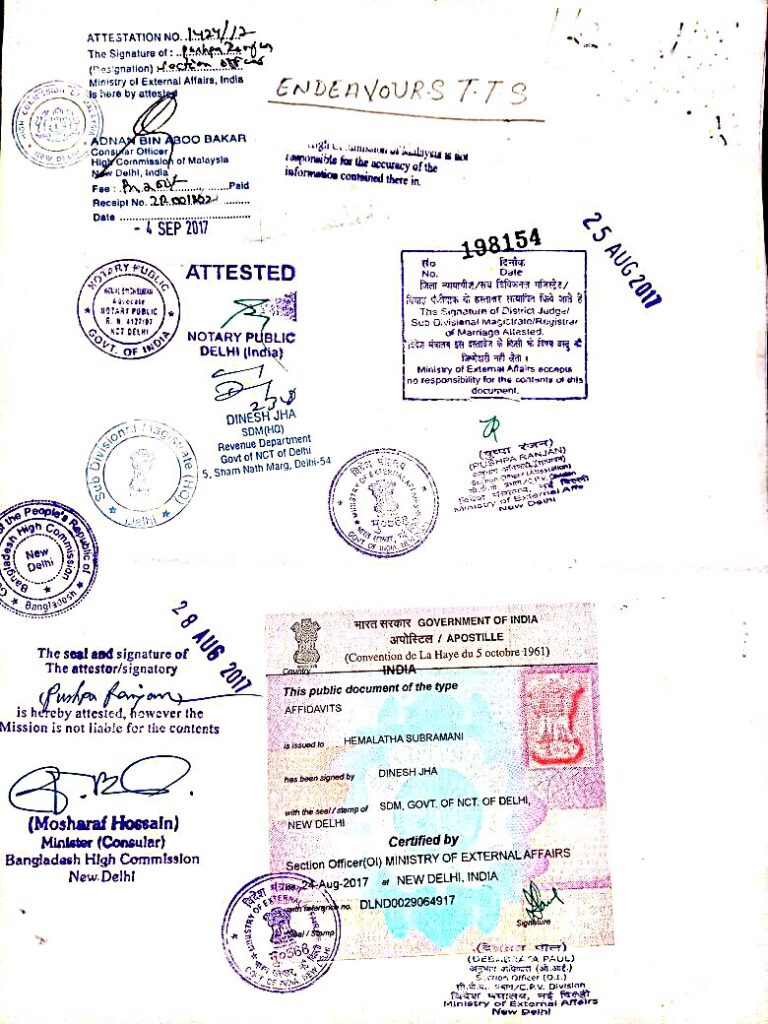Taking MEA (Ministry of External Affairs) Apostille services could be quite a lengthy procedure. However hard you try, you can still find yourself on the receiving end with a rejection of your application. It is important to know why this may occur and what one needs to do next which can reduce the difficulties and enhance the chances of a successful apostille process. This article focuses on understanding the causes of MEA apostille rejection, what to do after rejection, as well as the things that one should avoid in order to avoid future rejections to have an easier time when applying for apostille.
Simplifying MEA Apostille Rejections and the Reasons Behind Them
To begin tackling rejected MEA Apostille applications, it is imperative to explore the causes of rejection. Here are some of the most common reasons:
- Incomplete Documentation: Incompletely filled or improperly completed forms account for one of the greatest sources of rejection.
- Invalid or Expired Documents: Sending over documents that are invalid or have already expired will lead to the rejection of documents.
- Incorrect Apostille Fees: There are problems if the wrong fee is paid or a non-approved form of payment is used.
- Unclear or Illegible Copies: This means that some documents that are not distinguishable well enough may be disqualified on the grounds of not meeting the standard.
- Non-Compliant Document Format: Documents shall be properly formatted in accordance with the provisions of the MEA.
- Authentication Issues: Original documents were not certified and counterchecked by the right authorities before submission to MEA.
By being aware of the reasons for rejection, one is well equipped to prepare his application and avoid coming across such hitches.
What to Do If Your Apostille Application Has Been Denied
So, it is very important to act fast and without delays whenever a rejection has been made. Here’s what you should do immediately after receiving a rejection notice:
- Review the Rejection Notice: When rejecting your grant application, the funding agency will provide a rejection notice indicating why your application failed to meet the criteria.
- Gather Missing or Corrected Documents: Obtain any documents that may be omitted in the rejection notice or clarify any mistakes that may have been made.
- Check MEA Guidelines: Check on MEA guidelines for your documents and procedures to ensure they meet the recommended standards.
- Prepare for Resubmission: Sort out your papers and prepare corrections if you are going to redo the assignment.
How to Fix Mistakes and Re-Submit Your MEA Apostille Application
Submitting your application, correcting errors, and resubmitting your application is often a necessary factor for success. Here’s how to do it:
1. Identify Specific Errors:
- Go through your application thoroughly and try to locate the mistakes observed by the employer in the rejection note.
- Some of the common mistakes are wrong personal data, wrong type of document, or no authentication.
2. Correct Documentation Errors:
- Check that all particulars provided are correct and consistent with the documents provided.
- Verify the authenticity and validity of the documents to make sure that they are not fake or have expired.
- Make sure all the relevant papers have official stamps and signatures from the right offices before submitting them.
3. Improve Document Quality:
- Ensure all the copies are clean, legible, and of high quality according to the standards of MEA.
- Scan at the highest resolution possible and ensure that there are no fold lines or smudges on the document.
4. Recheck Apostille Fees:
- Check the amount of the fee and the modes of payment that has been given the green light. Check that the payment has been made properly.
5. Submit a New Application:
- You should then collate your corrected documents and prepare a new application in line with the MEA guidelines.
- Attach a cover letter outlining the changes made and the fact that the article was previously rejected by the journal.
Seeking Help: When and How to Contact MEA Apostille Support
At other times, it’s advisable to hire the services of professionals to help in the process of MEA Apostille. Here’s when and how to contact MEA Apostille support by Attestation Point:
1. When to Seek Help:
- For clarification on the reasons for rejection when one is not sure, the help of experts is advisable.
- This is when you experience multiple rejections, and are unable to pinpoint the problems that are present.
- Should you need help with the exact instructions on preparing your documents, please, do not hesitate to contact us.
2. How to Contact MEA Apostille Support:
- Via Phone: Contact MEA Apostille support helpline number offered by Attestation Point to avail immediate services.
- Email: Compose a detailed mail to the support team of Attestation Point and explain the problem faced and include necessary documents.
- In-Person Consultation: You can make an appointment with an Attestation Point specialist to discuss your application and get recommendations.
3. What to Expect from Support:
- Advice on how to rectify mistakes and how to apply for a change of status again in the future.
- Guidance in the collection and processing of the necessary papers, taking action in stages.
- Expert consultation on how to avoid violations of MEA guidelines and possible rejection of articles in the future.
Preventing Future Rejections: Guidelines for Apostille Process
To avoid the hassle of rejections and ensure a smooth MEA Apostille application process, consider these tips:
1. Thoroughly Check Requirements:
- Be familiar with the standard procedures and policies of MEA for apostille services.
- All the documents should be certified by the appropriate authorities before submission.
2. Use a Checklist:
- Develop a list of all documents and procedures essential to increase the likelihood of not forgetting any important aspect.
- Ensure you have checked all the items listed in the checklist before submitting the application.
3. Ensure Document Quality:
- Ensure that all the documents, whether original or copies, are quality, clear, and legibly printed.
- Make sure that the documents are not creased or tainted in any way from one’s fingers.
4. Double-Check Details:
- Check that your personal and any document particulars are correct and consistent with forms and any supporting documents.
- Names, dates, and identification numbers should be of particular interest.
5. Verify Payment Details:
- Ensure correct apostille fee amount and the accepted payment methods of MEA.
- It is important that you keep a copy of your payment confirmation for future use.
6. Seek Professional Assistance:
- If possible, seek the assistance of a reliable service provider such as Attestation Point for assistance.
- It is advisable to seek professional services for compliance with MEA requirements and better prospects of approval.
Conclusion
While being turned down for your MEA Apostille application may be discouraging, you have to know what to do to navigate this challenge. Knowledge of typical rejections, prompt addressing of corrective actions, and using professional assistance when needed can facilitate the process. If you adhere to the guidelines given above, you will not have to face rejection in future apostille processes and submissions.
Final Words
The implication of a rejected MEA Apostille application is not a dead end situation. It is imperative to observe and fix errors with haste and consult a professional if needed to get through the apostille process. Therefore, you should be very keen and make sure that you are abreast with the guidelines set by MEA to ensure that the application process is as smooth as possible.


